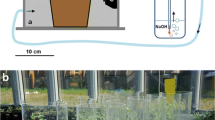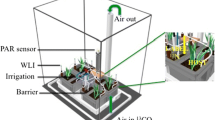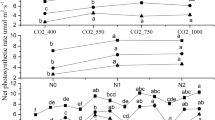Abstract
Enhanced soil respiration in response to elevated atmospheric CO2 has been demonstrated, and ectomycorrhizal (ECM) fungi are of particular interest since they partition host-derived photoassimilates belowground. Although a strong response of ECM fungi to elevated CO2 has been shown, little is still known about the functional diversity among species. We studied carbon (C) partitioning in mycorrhizal Scots pine seedlings in response to short-term CO2 enrichment, using seven ECM species with different ecological strategies. Mycorrhizal associations were synthesised and seedlings grown in large Petri dishes containing peat:vermiculite and nutrient solution for 10–15 weeks, after which half of the microcosms were exposed to elevated CO2 treatment (710 ppm) for 15 days and the other half were kept in ambient CO2 treatment. Partitioning of C was quantified by pulse labelling the seedlings with 14CO2 and examining the distribution of labelled assimilates in shoot, root and extraradical mycelial compartments by destructive harvest and liquid scintillation counting. Fungal biomass was determined with PLFA analysis. The respiratory loss of 14CO2 was on average greater in the elevated CO2 treatment for most species compared to the ambient CO2 treatment. More label was retrieved in the shoots in the ambient CO2 treatment compared to elevated CO2 (significant for P. involutus and P. fallax). Greater amounts of label were found in the extraradical mycelial compartment in all species (except P. involutus) in elevated CO2 compared to ambient CO2 (significant for L. bicolor, P. byssinum, P. fallax and R. roseolus). Fungal biomass production increased significantly with elevated CO2 for two species (H. velutipes and A. muscaria); three species (P. fallax, P. involutus and R. roseolus) showed a similar but non-significant trend, whereas L. bicolor and P. byssinum produced less biomass in elevated CO2 compared to ambient CO2. When 14C in the mycelial compartment and respiration was expressed per unit fungal PLFA the difference between CO2 treatments disappeared. We demonstrated that different ECM fungal isolates respond differently in C partitioning in response to CO2 enrichment. These results suggest that under certain growth conditions, when nutrients are not limiting, ECM fungi respond rapidly to increasing C-availability through changed biomass production and respiration.





Similar content being viewed by others

References
Alberton O, Kuyper TW, Gorissen A (2005) Taking mycocentrism seriously: mycorrhizal fungal and plant responses to elevated CO2. New Phytol 167:859–868
Alexander IJ (1983) The significance of ectomycorrhizas in the nitrogen cycle. In: McNeill L, Rorison IH (eds) Nitrogen as an ecological factor—the second symposium of the British Ecological Society. Blackwell Scientific Publications, Oxford, pp 69–93
Bhupinderpal-Singh, Nordgren A, Löfvenius MO, Högberg MN, Mellander PE, Högberg P (2003) Tree root and soil heterotrophic respiration as revealed by girdling of boreal Scots pine forest: extending observations beyond the first year. Plant Cell Environ 26:1287–1296
Bunce JA (1994) Responses of respiration to increasing atmospheric carbon dioxide concentrations. Physiol Plant 90:427–430
Deacon JW, Fleming LV (1992) Interactions of ectomycorrhizal fungi. In: Allen M (ed) Mycorrhizal functioning. Chapman and Hall, New York, pp 249–300
Dighton J, Mason PA (1985) Mycorrhizal dynamics during forest tree development. In: Moore D, Casselton LA, Wood DA (eds) Developmental biology of higher fungi. Cambridge University Press, Cambridge, pp 117–139
Dixon RK, Brown S, Houghton RA, Solomon AM, Trexler MC, Wisniewskij J (1994) Carbon pools and flux of global forest ecosystems. Science 263:185–190
Duddridge JA (1986) The development and ultrastructure of ectomycorrhizas 3. Compatible and incompatible interactions between Suillus grevillei Klotzsch Sing and 11 species of ectomycorrhizal hosts in vitro in the absence of exogenous carbohydrate. New Phytol 103:457–465
Eaton GK, Ayres MP (2002) Plasticity and constraint in growth and protein mineralization of ectomycorrhizal fungi under simulated nitrogen deposition. Mycologia 94:921–932
Finlay RD, Read DJ (1986) The structure and function of the vegetative mycelium of ectomycorrhizal plants: I. Translocation of 14C-labeled carbon between plants interconnected by a common mycelia. New Phytol 103:143–156
Fransson PMA, Finlay RD, Taylor AFS (2005) Mycelial production, spread and root colonisation of the ectomycorrhizal fungi Hebeloma crustuliniforme and Paxillus involutus under elevated atmospheric CO2. Mycorrhiza 15:25–31
Fransson PMA, Taylor AFS, Finlay RD (2001) Responses of the ectomycorrhizal community colonising roots of 37-year-old Norway spruce trees exposed to elevated CO2. New Phytol 152:431–442
Frostegård Å, Tunlid A, Bååth E (1993) Phospholipid fatty acid composition, biomass, and activity of microbial communities from two soil types experimentally exposed to different heavy metals. Appl Environ Microbiol 59:3605–3617
Genney DR, Anderson IC, Alexander IJ (2006) Fine-scale distribution of pine ectomycorrhizas and their extramatrical mycelium. New Phytol 170:381–390
Godbold DL, Berntson GM (1997) Elevated atmospheric CO2 concentration changes ectomycorrhizal morphotype assemblages in Betula papyrifera. Tree Physiol 17:347–350
Godbold DL, Berntson GM, Bazzaz FA (1997) Growth and mycorrhizal colonization of three North American tree species under elevated atmospheric CO2. New Phytol 137:433–440
Gorissen A, Kuyper TW (2000) Fungal species-specific responses of ectomycorrhizal Scots pine (Pinus sylvestris) to elevated CO2. New Phytol 146:163–168
Högberg P, Högberg MN (2002) Extramatrical ectomycorrhizal mycelium contributes one-third of microbial biomass and produces, together with associated roots, half the dissolved organic carbon in a forest soil. New Phytol 154:791–795
Högberg P, Nordgren A, Buchmann N, Taylor AFS, Ekblad A, Högberg MN, Nyberg G, Ottosson-Löfvenius M, Read DJ (2001) Large-scale forest girdling shows that current photosynthesis drives soil respiration. Nature 411:789–792
Ineichen K, Wiemken V, Wiemken A (1995) Shoots, roots and ectomycorrhiza formation of pine seedlings at elevated atmospheric carbon dioxide. Plant Cell Environ 18:703–707
King JS, Hanson PJ, Bernhardt E, Deangelis P, Norby RJ, Pregitzer KS (2004) A multiyear synthesis of soil respiration responses to elevated atmospheric CO2 from four forest FACE experiments. Global Change Biol 10:1027–1042
Klamer M, Roberts MS, Levine LH, Drake BG, Garland JL (2002) Influence of elevated CO2 on the fungal community in a coastal scrub oak forest soil investigated with Terminal-Restriction Fragment Length Polymorphism Analysis. Appl Environ Microb 68:4370–4376
Kuikka K, Harma E, Markkola A, Rautio P, Roitto M, Saikkonen K, Ahonen-Jonnarth U, Finlay R, Tuomia J (2003) Severe defoliation of Scots pine reduces reproductive investment by ectomycorrhizal symbionts. Ecology 84:2051–2061
Leake JR, Donnelly DP, Saunders EM, Boddy L, Read DJ (2001) Rates and quantities of carbon flux to ectomycorrhizal mycelium following 14C pulse labeling of Pinus sylvestris seedlings: effects of litter patches and interaction with a wood-decomposer fungus. Tree Physiol 21:71–82
Lilleskov EA, Fahey TJ, Horton TR, Lovett GM (2002) Belowground ectomycorrhizal fungal community change over a nitrogen deposition gradient in Alaska. Ecology 83:104–115
Marmeisse R, Guidot A, Gay G, Lambilliotte R, Sentenac H, Combier J-P, Melayah D, Fraissinet-Tachet L, Debaud JC (2004) Hebeloma cylindrosporum—a model species to study ectomycorrhizal symbiosis from gene to ecosystem. New Phytol 163:481–498
Marx DH, Bryan WC (1975) Growth and ectomycorrhizal development of loblolly pine seedlings in fumigated soil infected with the fungal symbiont Pisolithus tinctorius. For Sci 21:245–254
Melillo JM, Hall DO, Ågren GI (1996) Executive summary. In: Breymeyer AI, Hall DO, Melillo JM (eds) Scope 56. Global change: effects on coniferous forests and grasslands. Chichester pp 1–16
Norby RJ, Jackson RB (2000) Root dynamics and global change: seeking an ecosystem perspective. New Phytol 147:3–12
Rey A, Jarvis PG (1997) Growth response of young birch trees Betula pendula Roth. after four and a half years of CO2 exposure. Ann Bot 80:809–816
Rosling A, Landeweert R, Lindahl BD, Kuyper T, Finlay RD (2003) Vertical distribution of ectomycorrhizal fungal taxa in a podzol soil profile. New Phytol 159:775–783
Rouhier H, Read DJ (1998) Plant and fungal responses to elevated atmospheric carbon dioxide in mycorrhizal seedlings of Pinus sylvestris. Environ Exp Bot 40:237–246
Runion GB, Mitchell RJ, Rogers HH, Prior SA, Counts TK (1997) Effects of nitrogen and water limitation and elevated atmospheric CO2 on ectomycorrhiza of longleaf pine. New Phytol 137:681–689
Rygiewicz PT, Martin KJ, Tuininga AR (2000) Morphotype community structure of ectomycorrhizas on Douglas fir (Pseudotsuga menziesii Mirb. Franco) seedlings grown under elevated atmospheric CO2 and temperature. Oecologia 124:299–308
Schimel JP, Weintraub MN (2003) The implications of exoenzyme activity on microbial carbon and nitrogen limitation in soil: a theoretical model. Soil Biol Biochem 35:549–563
Söderström B (2002) Challenges for mycorrhizal research into the new millennium. Plant Soil 244:1–7
Söderström B, Read DJ (1987) Respiratory activity of intact and excised ectomycorrhizal mycelial systems growing in unsterilised soil. Soil Biol Biochem 19:231–236
Taylor AFS, Martin F, Read DJ (2000) Fungal diversity in ectomycorrhizal communities of Norway spruce (Picea abies [L.] Karst.) and beech (Fagus sylvatica L.) along north-south transects in Europe. In: E-D Schulze (ed) Carbon and nitrogen cycling in European forest ecosystems. Springer Verlag, Berlin, pp 343–365
Tingey DT, Phillips DL, Johnson MG (2000) Elevated CO2 and conifer roots: effects on growth, life span and turnover. New Phytol 147:87–103
Trueman R, Gonzalez-Meler MA (2005) Accelerated belowground C cycling in a managed agriforest ecosystem exposed to elevated carbon dioxide concentrations. Global Change Biol 11:1258–1271
Valentini R, Matteucci G, Dolman AJ et al (2000) Respiration as the main determinant of carbon balance in European forests. Nature 404:861–865
Wallander H, Nilsson LO, Hagerberg D, Rosengren U (2003) Direct estimates of C:N ratios of ectomycorrhizal mycelia collected from Norway spruce forest soils. Soil Biol Biochem 35:997–999
Wallenda T, Kottke I (1998) Nitrogen deposition and ectomycorrhizas. New Phytol 139:169–187
Acknowledgements
We thank Francis Martin, Ulla Ahonen-Jonnart, Björn Lindahl and Andy Taylor for fungal isolates, and Dave Johnson for valuable input into the isotope work. We also thank Allan Sim who kindly assisted with technical support, Colin Campbell for feedback on PLFA extractions, and Jeri Parrent and Roger Finlay for reading the manuscript. Funding was provided by Carl Trygger’s foundation and the UK National Environment Research Council. ICA receives funding from the Scottish Executive Environment and Rural Affairs Department.
Author information
Authors and Affiliations
Corresponding author
Rights and permissions
About this article
Cite this article
Fransson, P.M.A., Anderson, I.C. & Alexander, I.J. Does carbon partitioning in ectomycorrhizal pine seedlings under elevated CO2 vary with fungal species?. Plant Soil 291, 323–333 (2007). https://doi.org/10.1007/s11104-007-9203-y
Received:
Accepted:
Published:
Issue Date:
DOI: https://doi.org/10.1007/s11104-007-9203-y



